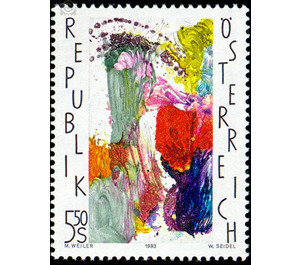Modern Art - Austria / II. Republic of Austria 1993 - 5.50 Shilling
Theme: Art & Culture
| Country | Austria / II. Republic of Austria |
| Issue Date | 1993 |
| Face Value | 5.50 |
| Color | multi-colored white |
| Printing Type | combination printing |
| Stamp Type | Commemorative |
| Item Type | Stamp |
| Chronological Issue Number | 1453 |
| Chronological Chapter | OOS-OE2 |
| SID | 448353 |
| In 71 Wishlists | |
The brand motif shows one of the abstract works of the artist in which he documents experienced natural conditions. Not one-dimensional representation, but multi-dimensional processing of the processing process of impressions is the goal of Max Weiler. The artist studied from 1930-36 at the Vienna Academy of Fine Arts, then worked in Innsbruck. In the last years of the war he had to join the Wehrmacht. After the war he returned to Innsbruck where, with his frescoes in the Theresienkirche on the Hungerburg near Innsbruck, he caused not only Austria-wide but also a far-reaching sensation. With the translation of Christian salvation into a contemporary Tyrolean ambience, as can be seen on these frescoes, he pioneered the way for modernity in western Austria. In Vienna, he was only able to gain a lasting foothold with his professorship at the Academy of Fine Arts in 1964.


